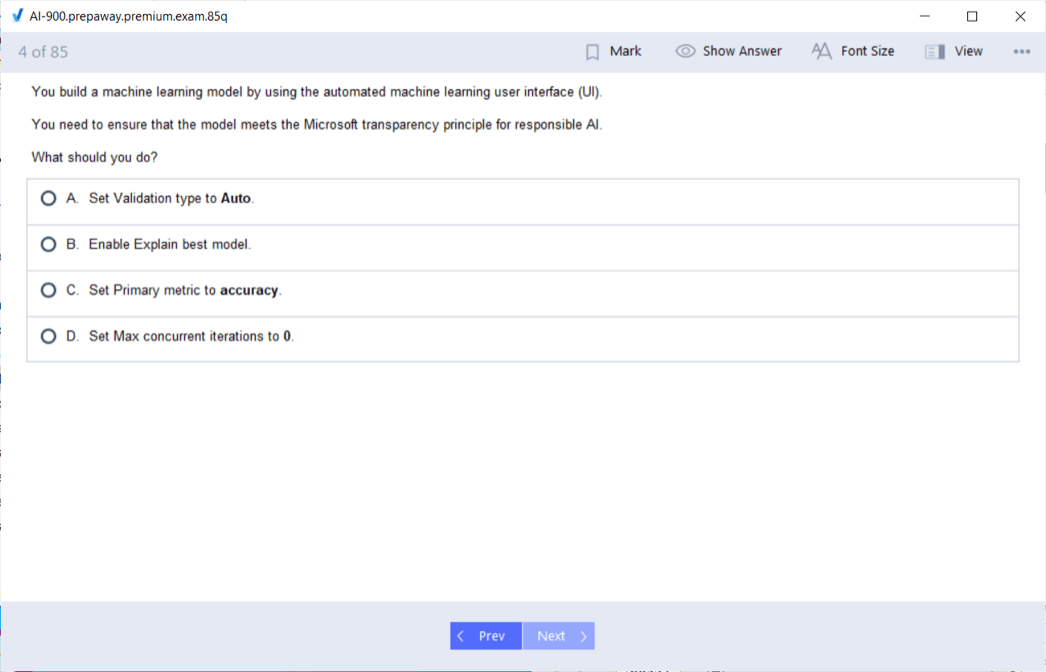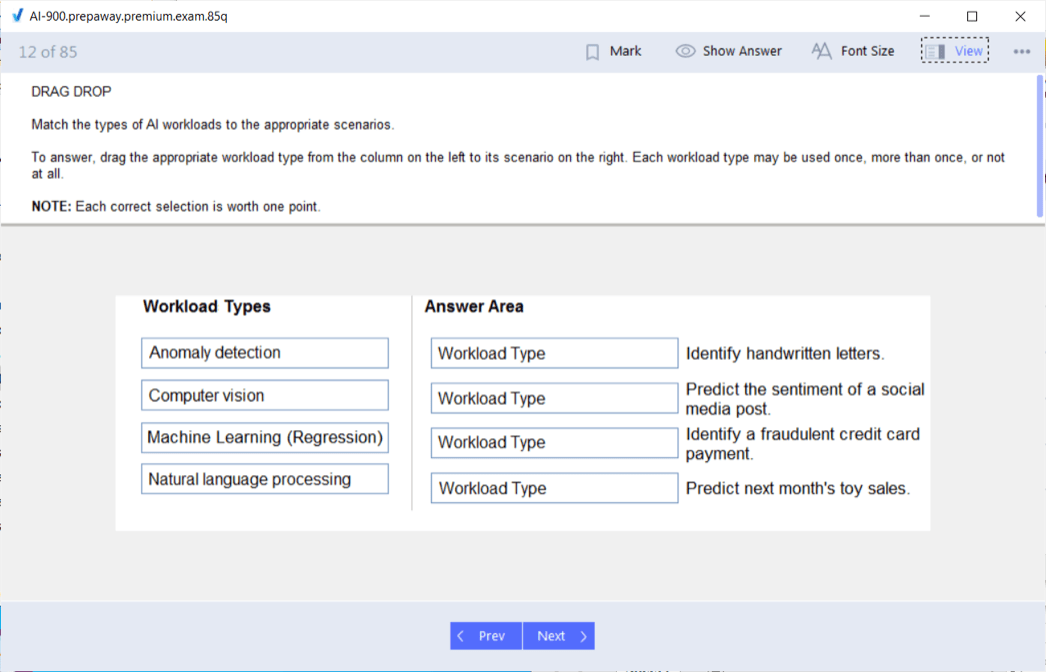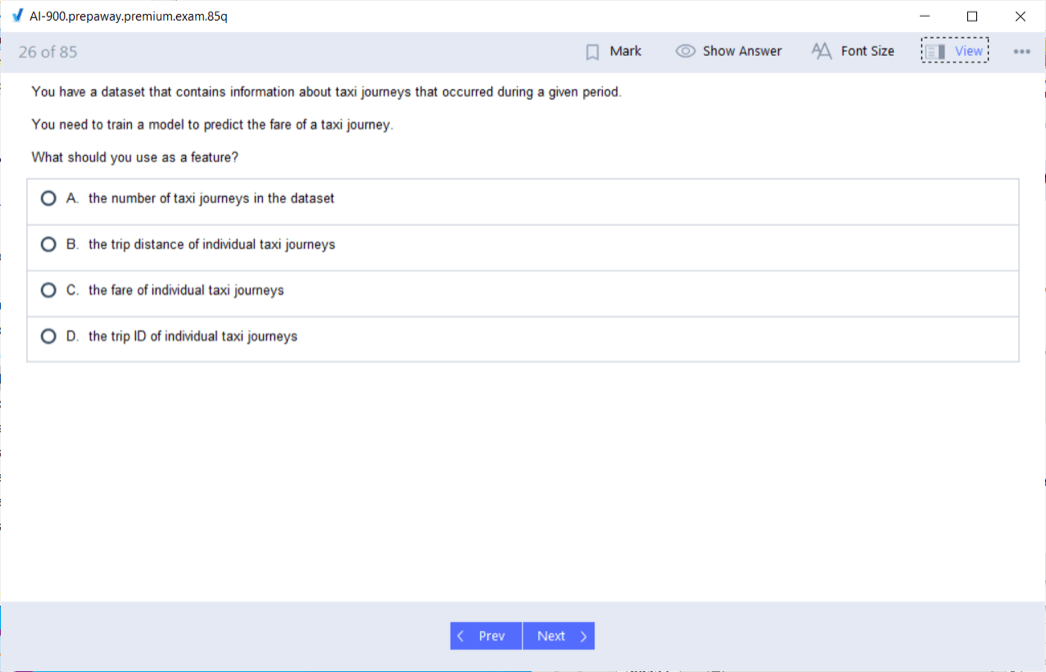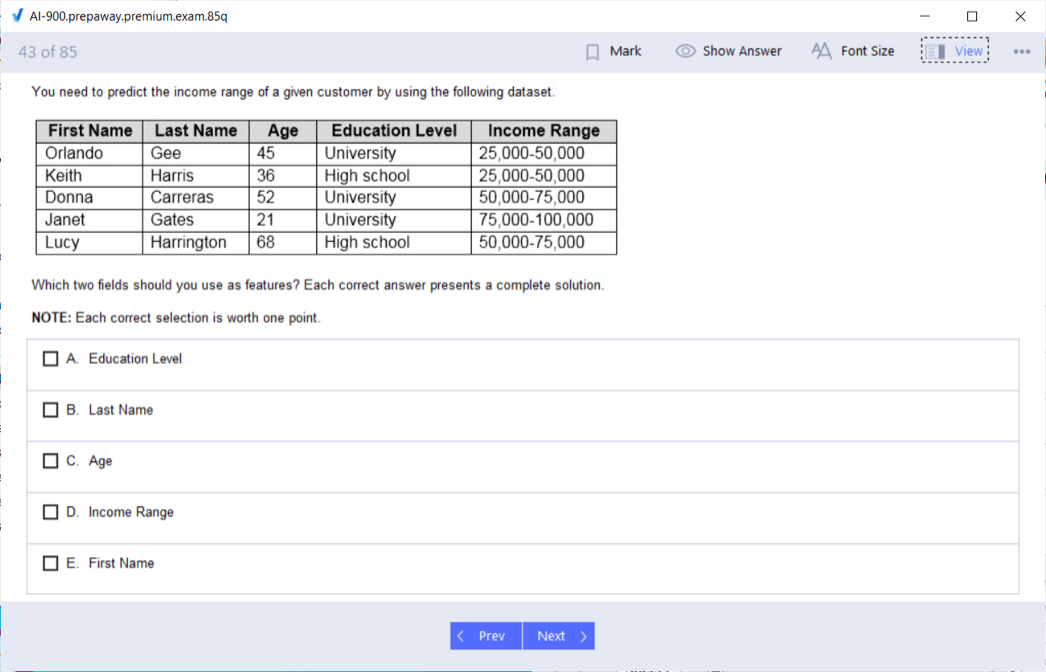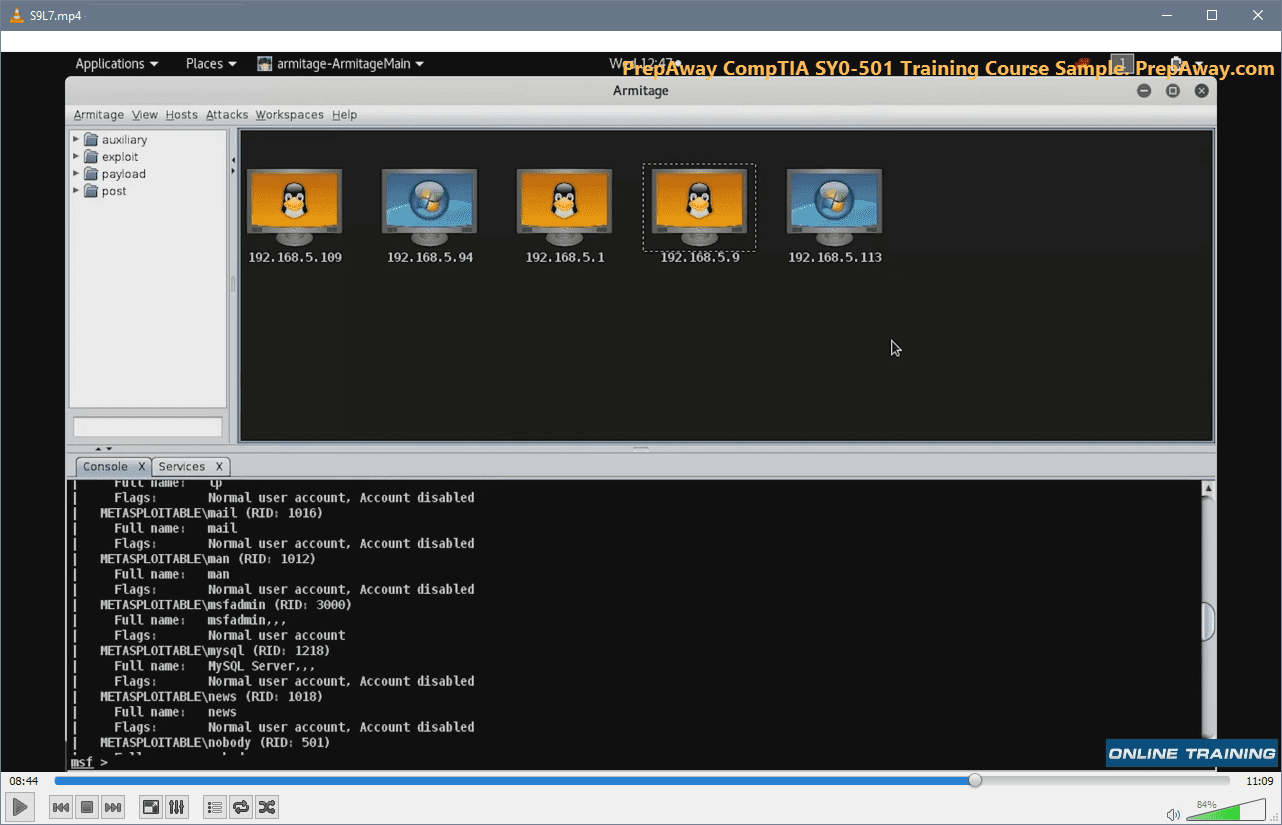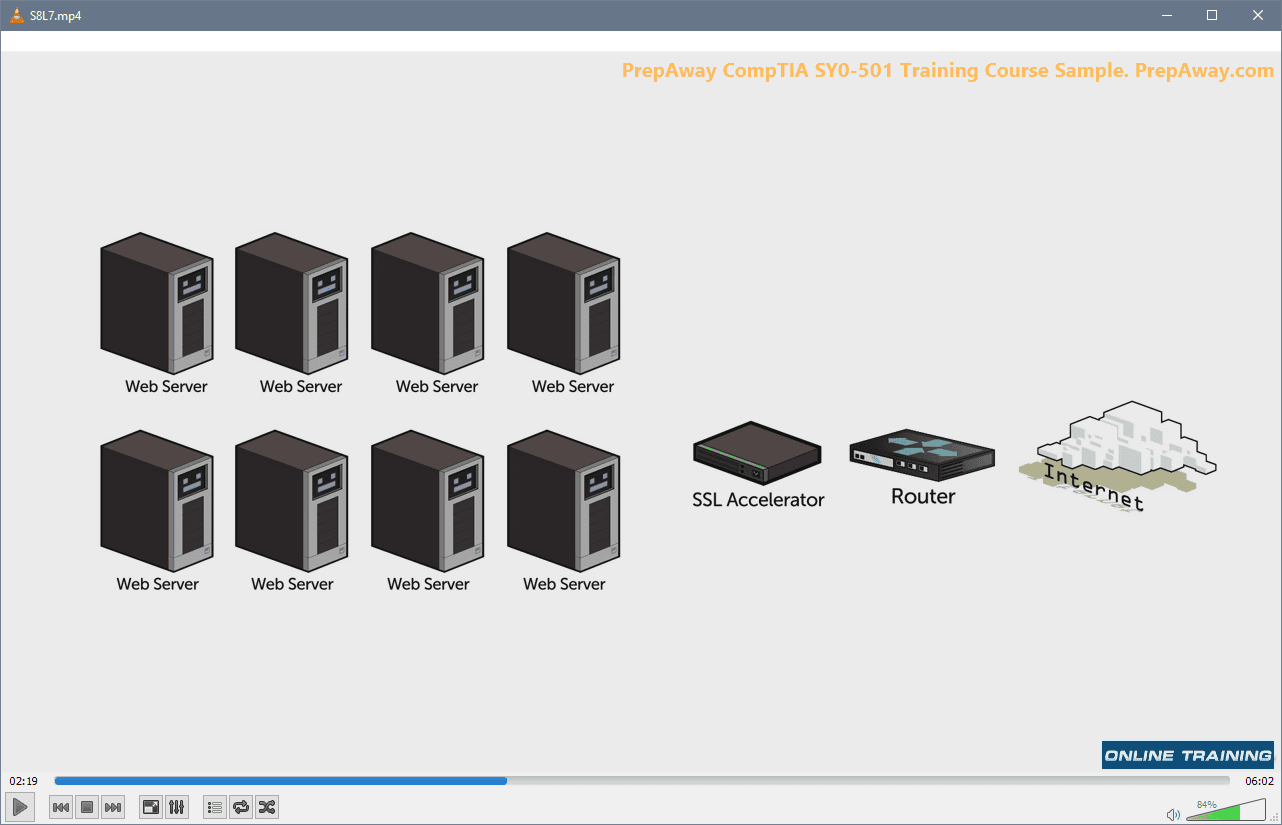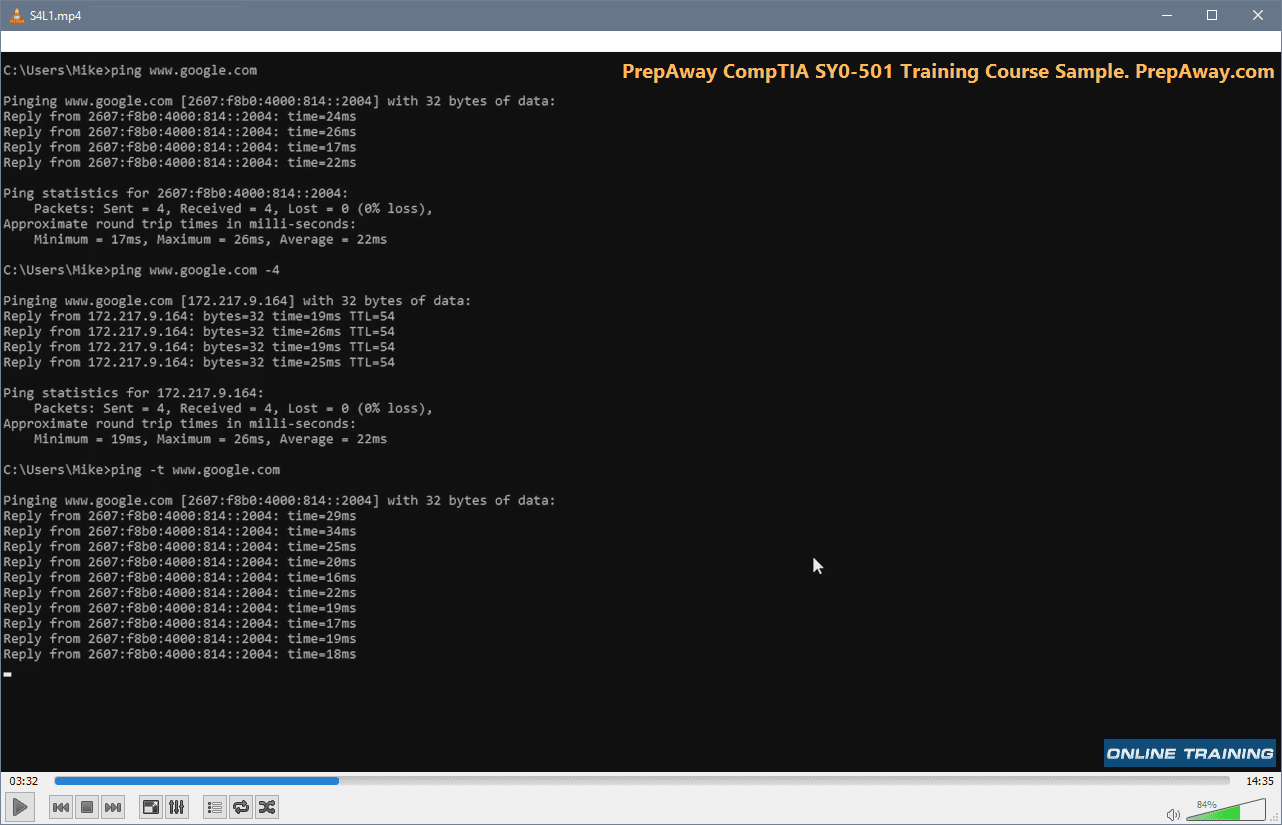- Home
- Microsoft Certifications
- AI-900 Microsoft Azure AI Fundamentals Dumps
Pass Microsoft Azure AI AI-900 Exam in First Attempt Guaranteed!
Get 100% Latest Exam Questions, Accurate & Verified Answers to Pass the Actual Exam!
30 Days Free Updates, Instant Download!

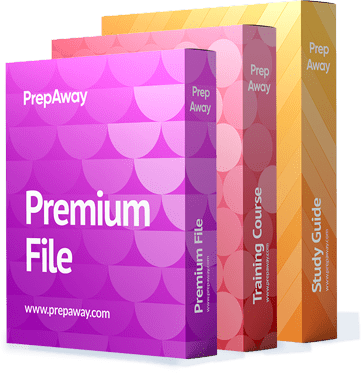
AI-900 Premium Bundle
- Premium File 303 Questions & Answers. Last update: Nov 30, 2025
- Training Course 85 Video Lectures
- Study Guide 391 Pages
Last Week Results!
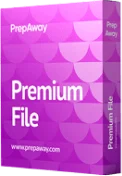
Includes question types found on the actual exam such as drag and drop, simulation, type-in and fill-in-the-blank.
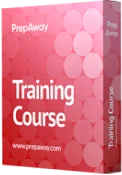
Based on real-life scenarios similar to those encountered in the exam, allowing you to learn by working with real equipment.

Developed by IT experts who have passed the exam in the past. Covers in-depth knowledge required for exam preparation.
All Microsoft Azure AI AI-900 certification exam dumps, study guide, training courses are Prepared by industry experts. PrepAway's ETE files povide the AI-900 Microsoft Azure AI Fundamentals practice test questions and answers & exam dumps, study guide and training courses help you study and pass hassle-free!
AI-900 Exam Success as a Non-Technical Professional: Step-by-Step Guide
The Microsoft Certified: Azure AI Fundamentals AI-900 certification is designed for individuals who want to understand the fundamentals of artificial intelligence and machine learning on the Azure platform. This certification is suitable for beginners and non-technical professionals who wish to gain foundational knowledge of AI concepts, workloads, and Azure services that support AI. The AI-900 is an entry-level certification, but it covers a wide range of topics, from understanding AI workloads to exploring Azure AI services and responsible AI principles.
Earning this certification demonstrates a clear understanding of AI fundamentals, Azure AI tools, and the practical applications of AI in real-world scenarios. It provides a starting point for a career in AI or as a prerequisite for more advanced certifications, including AI-102 or Azure Machine Learning certifications. The exam is structured to test your knowledge across different AI domains, including machine learning, computer vision, natural language processing, and generative AI, as well as ethical and responsible AI practices.
Understanding the Exam Structure
The AI-900 exam consists of 45 questions to be answered within a 45-minute time frame. The questions are scenario-based, multiple-choice, and multiple-response, focusing on assessing both conceptual understanding and practical knowledge. Candidates are expected to identify appropriate AI workloads, describe machine learning principles, and understand the features of Azure AI services without performing complex implementations or deployments.
The exam is divided into several key domains, each covering specific topics. Understanding these domains and their weightings helps in structuring your study plan effectively. Candidates need to familiarize themselves with Azure AI services such as Azure Machine Learning Studio, Cognitive Services, and Azure OpenAI Service. The exam also emphasizes responsible AI principles, including fairness, accountability, transparency, and ethical AI development.
Exam preparation requires a combination of theoretical study and hands-on practice. Microsoft Learn modules provide structured lessons and exercises to build foundational knowledge, while practice exams simulate the test environment, allowing candidates to assess their readiness and identify areas requiring further focus. Using timed practice tests helps in managing exam time effectively and reduces anxiety on the actual exam day.
The First Step: Leveraging Resources
The first step in preparing for the AI-900 is identifying and utilizing available resources. Microsoft offers free learning paths that cover all exam domains in a structured manner. These modules introduce key concepts, provide examples, and include interactive exercises to reinforce understanding. Candidates can explore AI workloads, Azure services, and responsible AI principles through these learning paths.
In addition to official Microsoft resources, candidates can use practice tests to evaluate their knowledge and gain familiarity with the exam format. Practice exams highlight knowledge gaps and provide explanations for correct answers, helping learners reinforce their understanding of complex topics. Hands-on labs and sandbox environments allow candidates to interact with Azure AI services directly, which is particularly beneficial for non-technical learners to gain confidence and practical experience.
Managing study time effectively is critical. Breaking down the exam syllabus into smaller sections and studying each domain individually allows for better retention. Candidates should focus on areas with higher exam weightings, such as AI workloads, machine learning fundamentals, and generative AI, while ensuring all domains are covered. Regular revision, note-taking, and practice tests contribute significantly to exam success.
Understanding AI Workloads and Considerations
The first domain of the AI-900 focuses on understanding artificial intelligence workloads and considerations. This includes learning how AI can be applied in different scenarios, the types of AI solutions available, and the business and ethical implications of AI deployments. Candidates are expected to describe AI workloads such as anomaly detection, knowledge mining, predictive analytics, and conversational AI.
Ethical considerations are central to this domain. Microsoft emphasizes responsible AI principles, which include fairness, accountability, transparency, reliability, privacy, and inclusiveness. Candidates need to understand how these principles impact AI solution design and deployment. Exam questions may present scenarios requiring candidates to identify ethical concerns or select appropriate AI approaches while considering cost, planning, and potential risks.
Real-world examples are effective for understanding AI workloads. Candidates can relate AI concepts to familiar services like recommendation engines, virtual assistants, and chatbots. Imagining how AI functions in everyday applications helps retain information and answer scenario-based questions with confidence. Knowledge of responsible AI practices ensures that candidates can align AI solutions with ethical standards, which is increasingly important in modern AI applications.
Machine Learning Fundamentals on Azure
The AI-900 requires candidates to describe fundamental principles of machine learning and understand how Azure supports these processes. This includes recognizing types of machine learning, such as supervised, unsupervised, and reinforcement learning, as well as concepts like training, validation, testing, and model evaluation. Understanding these principles helps in identifying appropriate workloads and assessing model performance.
Azure Machine Learning Studio is the primary tool for building and deploying machine learning models. Candidates should be familiar with its capabilities, including automated machine learning, model management, and data preparation. Knowledge of AutoML allows non-technical learners to understand how Azure simplifies model training and deployment without requiring deep coding skills.
Hands-on practice is essential. Interacting with datasets, training models, and evaluating outputs in a sandbox environment reinforces theoretical knowledge. Scenario-based questions may ask candidates to select the appropriate machine learning approach for a given problem or identify the tools suitable for specific tasks. Understanding these fundamentals ensures a solid foundation for advanced AI concepts and exam success.
Understanding Computer Vision Workloads on Azure
Computer vision is one of the primary domains of the AI-900 exam and focuses on enabling systems to interpret and understand visual data such as images and videos. This domain covers the fundamental principles of computer vision, the Azure services that support it, and real-world applications where computer vision is applied. Candidates are expected to describe how computer vision works, recognize different types of computer vision workloads, and understand when and how to use Azure services effectively.
Computer vision allows machines to see and process visual input similarly to humans. It involves tasks such as object detection, facial recognition, image classification, and text extraction from images. Azure provides multiple services that simplify computer vision implementations, allowing even non-technical learners to understand and leverage these capabilities. Azure services like Computer Vision, Custom Vision, Face API, and Form Recognizer provide ready-to-use solutions for different computer vision tasks. Understanding the purpose and capabilities of these services is crucial for passing the AI-900 exam.
Real-world scenarios enhance comprehension of computer vision workloads. For example, retail businesses use image classification to automatically categorize products, while security systems use facial recognition to authorize access. Optical character recognition (OCR) is widely applied in document management to extract text from scanned files. By connecting these examples to Azure services, candidates can easily recall which service to apply in specific situations.
Exploring Azure Computer Vision Services
Azure offers a suite of services for computer vision, each serving a specific purpose. The Computer Vision API enables image and video analysis, providing features like object detection, text extraction, and scene understanding. Custom Vision allows users to build models tailored to their specific needs, training models on custom datasets to classify images accurately.
The Face API focuses on facial recognition, identifying and verifying individuals within images and videos. It supports features like emotion detection and facial attribute analysis. Form Recognizer extracts information from structured and unstructured documents, enabling automation of tasks such as invoice processing or survey data collection. Familiarity with these services, their use cases, and their input-output characteristics is essential for exam preparation.
Candidates are expected to recognize scenarios where each service is applicable. For instance, if an exam question presents a scenario of extracting information from invoices, the correct answer would involve Form Recognizer. Understanding the functional distinctions between services ensures that candidates can select the most appropriate solution in practical situations, which is a critical skill tested in the AI-900 exam.
Natural Language Processing Workloads on Azure
Natural language processing, or NLP, is another significant domain of the AI-900 exam. NLP enables systems to understand, interpret, and generate human language. This domain covers Azure services that support text analysis, translation, speech recognition, and conversational AI applications. Candidates need to describe NLP workloads, understand the underlying concepts, and identify relevant Azure services.
Azure provides several services for NLP, including Azure Language, Speech, Translator, and the Bot Framework. Azure Language enables text analysis, extracting key phrases, recognizing entities, and detecting sentiment. Speech services convert spoken language into text and provide text-to-speech capabilities. Translator allows real-time language translation across multiple languages. The Bot Framework facilitates the development of conversational AI applications, such as chatbots for customer support or virtual assistants.
Hands-on experience reinforces understanding. Trying out Azure demos for text-to-speech, language translation, and key phrase extraction helps candidates remember service functionalities and practical applications. For example, experimenting with Azure Speech to convert phrases into audio demonstrates the capabilities of speech services. Similarly, using Translator for a sample text exercise shows how NLP can bridge language barriers in real-world applications.
Scenario-based practice is highly effective for this domain. Questions often present a problem, such as analyzing customer feedback or generating automated responses. Candidates are expected to identify which Azure service addresses the problem most efficiently. Understanding practical applications of NLP in business, healthcare, e-commerce, and education helps connect exam questions with real-world use cases.
Generative AI Workloads on Azure
Generative AI is an emerging domain within AI-900, focusing on AI systems that create new content, including text, images, or code. This section covers Azure services that support generative AI, the differences between generative AI and NLP, and real-world applications of AI-driven content creation. Candidates are expected to understand foundation models, prompt engineering, and scenarios where generative AI is applied.
Azure OpenAI Service enables access to advanced language models capable of text generation, summarization, and question answering. DALL-E or similar services allow image generation based on prompts, creating visual content without manual input. These services exemplify how generative AI transforms creative processes and automates content generation. Understanding how these models work conceptually and how to apply them in scenarios is crucial for the exam.
Generative AI differs from NLP in that it creates content, whereas NLP primarily analyzes and interprets existing content. For example, a chatbot that analyzes customer feedback uses NLP, while a system that generates a marketing email or image from a prompt uses generative AI. Candidates should be able to identify the appropriate technology based on the desired outcome.
Practical exercises strengthen comprehension. Experimenting with text prompts in Azure OpenAI Service, generating images from descriptive phrases, or using summarization tools helps candidates visualize applications. Scenario-based questions often involve selecting the correct service for a content generation task. Understanding model limitations, ethical considerations, and prompt design strategies ensures candidates can answer accurately and responsibly.
Responsible AI Principles
Ethics and responsibility are central to AI-900. The exam emphasizes understanding principles of responsible AI, including fairness, transparency, accountability, privacy, reliability, and inclusiveness. Candidates are expected to describe how these principles guide AI development and deployment on Azure, and how to mitigate bias or unintended consequences.
Azure provides tools to enforce responsible AI practices. SageMaker Clarify, Model Cards, and monitoring solutions help detect bias, ensure fairness, and maintain transparency. Candidates need to understand how to apply these principles conceptually, even without implementing technical solutions. Knowledge of responsible AI ensures candidates can address ethical concerns in scenario-based exam questions.
Real-world application of responsible AI principles includes evaluating training data for bias, ensuring explainable model outputs, and maintaining privacy when handling sensitive information. Understanding these concepts helps candidates connect exam content with the practical responsibilities of AI developers, managers, or analysts.
Security, Compliance, and Governance for AI
AI solutions must be secure, compliant, and well-governed. The AI-900 exam includes a focus on security and governance considerations, including data protection, identity management, and regulatory compliance. Candidates are expected to describe security best practices and identify Azure services that help maintain compliance.
Azure services like Identity and Access Management, Azure Macie, and Config assist in safeguarding AI systems. IAM controls access to AI resources, Macie identifies sensitive data, and Config tracks resource compliance. Understanding the purpose and capabilities of these services ensures candidates can address security and governance questions effectively.
Scenario-based exam questions often present situations requiring candidates to choose the appropriate security or governance solution. For example, protecting sensitive customer data in AI models may involve implementing data classification and access policies. Connecting concepts to real-world scenarios ensures candidates can make informed decisions under exam conditions.
Effective Study Strategies for AI-900
Preparation for the AI-900 exam requires more than passive reading. Developing an effective study strategy ensures that candidates understand the exam content, retain knowledge, and can apply concepts to real-world scenarios. Dividing the material into manageable sections, focusing on hands-on experience, and consistent practice are essential. Understanding each domain in context helps retain information and prepares candidates to tackle scenario-based questions efficiently.
Creating a study plan is a critical first step. Allocate time for each domain, starting with areas that are conceptually more challenging, such as machine learning principles or generative AI workloads. Allow sufficient time for hands-on experimentation with Azure services, including Computer Vision, NLP, and OpenAI services. Scheduling short, focused study sessions daily encourages retention and prevents overwhelm. A study plan should balance theoretical reading with practical exercises to reinforce learning.
Breaking the AI-900 syllabus into smaller chunks enhances comprehension. For example, understanding AI workloads can be divided into exploring machine learning types, AI model training, and ethical considerations. Similarly, computer vision can be separated into understanding object detection, facial recognition, and OCR capabilities. Studying in these increments ensures that candidates focus on specific objectives, making revision more efficient and effective.
Leveraging Hands-On Labs and Sandbox Environments
Hands-on practice is invaluable for AI-900 preparation. Azure provides sandbox environments and interactive labs that allow candidates to explore AI services without affecting production resources. Engaging with these labs enables candidates to apply theoretical knowledge, experiment with different configurations, and observe the outcomes in a safe environment.
For computer vision, candidates can practice uploading images to the Computer Vision API, testing object detection, and exploring Custom Vision training. For NLP, experimenting with sentiment analysis, key phrase extraction, and language translation provides a deeper understanding of how these services function. Generative AI exercises, such as using Azure OpenAI to create text or images, familiarize candidates with prompt design and content generation.
Hands-on labs reinforce learning by providing tangible experience with Azure services. They also develop problem-solving skills by allowing candidates to troubleshoot common errors and test multiple approaches. This active learning process helps solidify understanding, making it easier to recall concepts during the exam.
Practice Tests and Exam Simulations
Practice exams are an essential component of AI-900 preparation. They familiarize candidates with the exam format, question types, and time constraints. Completing multiple practice tests builds confidence, identifies weak areas, and improves time management skills.
Candidates should use a mix of multiple-choice, multiple-response, and scenario-based practice questions. Scenario-based questions are particularly important as they test the candidate’s ability to apply concepts to practical situations, which is a major focus of the AI-900 exam. Reviewing explanations for both correct and incorrect answers helps clarify misunderstandings and reinforces learning.
Timed simulations are effective in preparing for exam conditions. The AI-900 exam allows approximately 45 minutes for 45 questions. Practicing under these conditions helps candidates develop pacing strategies, ensuring they can answer all questions comfortably. Bookmarking difficult questions during simulations and returning to them later is a useful strategy to maximize accuracy and efficiency.
Building Conceptual Understanding
Developing a strong conceptual understanding is essential for AI-900. Memorization alone is insufficient, especially for scenario-based questions that require critical thinking. Candidates should focus on understanding how AI and ML concepts interrelate, how Azure services are applied, and how to identify the right solution for a given problem.
For machine learning principles, candidates should understand the differences between supervised, unsupervised, and reinforcement learning. Concepts like model training, validation datasets, bias, fairness, and overfitting should be well understood. Relating these concepts to Azure Machine Learning Studio and AutoML helps bridge theory with practical application.
For computer vision, understanding object detection, image classification, facial recognition, and OCR is crucial. Candidates should know which Azure service is suitable for each task and understand its capabilities at a high level. Connecting these tasks to real-world scenarios, such as automated quality control in manufacturing or facial recognition for security, enhances comprehension.
For NLP, candidates should understand text analysis, sentiment detection, speech recognition, and language translation. Knowing which Azure services support these functionalities, and practicing with demo tools, reinforces understanding and prepares candidates for scenario-based questions.
Using Azure Learning Resources
Azure provides structured learning paths for AI-900 preparation. Microsoft Learn modules offer guided tutorials, interactive exercises, and theoretical explanations that align with the exam syllabus. These modules cover all five domains, providing both foundational knowledge and practical exercises.
Learning resources include video courses, documentation, and guided labs. Combining these resources ensures that candidates receive a balanced approach to learning, incorporating visual, auditory, and hands-on learning styles. Reviewing modules multiple times strengthens retention and understanding, particularly for complex concepts such as generative AI or ethical AI principles.
Candidates should take advantage of free training resources, including sandbox environments and demos, to gain hands-on experience. Exploring Azure AI services through these environments helps candidates visualize workflows, experiment with data inputs and outputs, and reinforce their understanding of service capabilities.
Time Management and Study Discipline
Time management is a critical component of exam preparation. Creating a structured study schedule ensures that all domains are covered thoroughly before the exam. Allocate more time to weaker areas, while revisiting previously studied topics to reinforce memory. Consistent daily practice, even in short intervals, is more effective than irregular, long study sessions.
Tracking progress helps maintain motivation and ensures that candidates are aware of areas requiring additional focus. Using checklists, study logs, or digital planners to monitor completion of practice exercises, video modules, and practice tests enhances organization. Adjusting the study plan based on performance in practice tests ensures a targeted and efficient preparation approach.
Avoiding last-minute cramming reduces exam anxiety. Familiarity with all domains, combined with practice under timed conditions, helps candidates approach the exam with confidence. Spacing study sessions and reviewing content periodically improves long-term retention and reduces stress on exam day.
Exam Anxiety and Mental Preparation
Managing exam anxiety is essential for optimal performance. Even with thorough preparation, stress can affect concentration and recall. Developing strategies to stay calm and focused enhances performance. Techniques such as deep breathing, mindfulness, and short breaks during study sessions can reduce anxiety.
Practicing with simulated exams under timed conditions helps candidates become comfortable with the exam format and pacing. Familiarity with question types, exam environment, and timing reduces uncertainty and increases confidence. Approaching difficult questions methodically, rather than panicking, improves accuracy.
Maintaining a positive mindset is equally important. Understanding that AI-900 is foundational and designed for beginners helps reduce intimidation. Focusing on strengths, reviewing weak areas, and practicing consistently builds confidence and readiness.
Tracking Performance and Improvement
Regular assessment of performance helps identify areas for improvement. Practice tests, hands-on exercises, and self-quizzes provide insights into knowledge gaps. Analyzing incorrect answers, understanding the rationale, and revisiting weak areas ensure continuous improvement.
Performance tracking also helps prioritize study time. Areas consistently answered correctly require less focus, while challenging topics receive more attention. This targeted approach ensures efficient use of study time and maximizes preparedness for the exam.
Final Preparation Strategies for AI-900
The final stage of AI-900 preparation involves consolidating knowledge, reinforcing weak areas, and ensuring readiness for exam day. At this point, candidates should have already studied the five domains: AI workloads, machine learning principles, computer vision, natural language processing, and generative AI, along with ethical considerations and governance. The focus now shifts to active revision, hands-on reinforcement, and building confidence.
A recommended approach is to create a comprehensive summary of all key concepts. This summary should include definitions, key services, typical use cases, and relevant examples. Candidates can use charts, tables, and diagrams to visually organize information, which aids memory retention and makes last-minute revision more effective. Reviewing this condensed material multiple times in the final week helps ensure that all domains remain fresh.
Another effective strategy is to revisit practice exams with a critical eye. Analyze questions answered incorrectly or guessed and ensure understanding of the correct answers. Candidates should pay particular attention to scenario-based questions, which are common on AI-900. Understanding why a specific service is appropriate for a given scenario, and being able to explain the reasoning, is essential.
Hands-On Reinforcement
Practical experience solidifies theoretical knowledge. Candidates should allocate time to experiment with Azure AI services, revisiting prior hands-on labs and exploring new scenarios. For computer vision, try training Custom Vision models on new image datasets or testing OCR with different document types. For NLP, practice sentiment analysis on customer reviews or use language translation services with diverse text inputs.
Generative AI practice is especially important due to its increasing prominence on the exam. Candidates should explore text generation using Azure OpenAI, experimenting with prompts to understand how the models interpret instructions and produce outputs. Image generation exercises, for example, with DALL-E, allow candidates to see the practical application of generative AI and prepare for related scenario questions.
Practical exercises not only reinforce learning but also build confidence in navigating the Azure environment. Being comfortable with the interface, tools, and output expectations reduces exam-day anxiety and helps candidates respond accurately to scenario-based questions.
Exam Day Readiness
On the day of the exam, preparation extends beyond knowledge alone. Candidates should focus on creating the optimal environment and mindset for performance. For in-person exams, arrive at the test center early with valid identification and necessary materials. For online proctored exams, ensure a quiet, well-lit space with a reliable internet connection and minimal distractions.
Time management during the exam is crucial. The AI-900 typically consists of 45 questions to be answered in 45 minutes. Candidates should pace themselves to avoid spending excessive time on any single question. For questions that seem challenging, use a bookmark strategy and return to them later. This ensures that easier questions are answered first and helps maintain momentum throughout the exam.
Reading questions carefully is essential. Scenario-based questions often include multiple plausible options, and the correct answer is typically the one that aligns most closely with Azure’s recommended approach or best practices. Candidates should focus on the task described and relate it to the service or AI principle that most appropriately addresses it.
Managing Exam Anxiety
Even well-prepared candidates may experience exam anxiety. Strategies for managing stress include deep breathing, positive self-talk, and visualizing success. Confidence grows from preparation and familiarity with exam content. Practicing with timed mock exams under similar conditions to the actual test helps reduce uncertainty and improve focus.
Maintaining a calm and focused mindset allows candidates to think clearly and apply knowledge effectively. Understanding that the AI-900 is a foundational exam and designed to be approachable for beginners helps reduce intimidation. Staying present and methodical during the exam increases the likelihood of success.
Post-Exam Steps
After completing the exam, candidates should review their results and understand the feedback provided. Passing the AI-900 demonstrates proficiency in foundational AI concepts and Azure AI services. It is also a stepping stone to more advanced certifications, such as AI-102 or the Azure Machine Learning certifications.
Candidates can use the knowledge gained from AI-900 to pursue practical projects. For example, developing simple machine learning models using Azure Machine Learning Studio, building chatbots with Azure Bot Service, or experimenting with generative AI for content creation. Applying knowledge in real-world scenarios reinforces learning and builds practical skills that are valuable in professional settings.
For those who do not pass on the first attempt, it is important to analyze weak areas and continue practicing. Understanding the reasoning behind incorrect answers and revisiting hands-on labs will improve readiness for a retake. Scheduling the retake with adequate preparation time and using targeted study techniques increases the likelihood of success.
Applying AI-900 Knowledge in Real-World Projects
AI-900 knowledge is not only useful for exams but also for professional growth. Understanding AI workloads, machine learning principles, and Azure AI services enables candidates to identify opportunities for AI integration in business processes. Examples include using computer vision for inventory management, NLP for customer feedback analysis, or generative AI for marketing content creation.
Building small-scale projects allows candidates to explore service capabilities and limitations. Experimenting with different data inputs, tuning parameters, and analyzing outputs enhances practical understanding. Sharing these projects on portfolios or GitHub can showcase skills to employers and strengthen career opportunities.
Collaboration with peers or within professional communities also enriches learning. Discussing use cases, sharing challenges, and reviewing solutions fosters a deeper understanding of AI principles and Azure services. Engaging in community challenges or hackathons provides practical experience and encourages creative problem-solving.
Ethical AI and Responsible Use
AI-900 emphasizes the importance of ethical AI and responsible use of AI technologies. Candidates should understand Microsoft’s responsible AI principles, including fairness, transparency, accountability, and privacy. Applying these principles in practical projects ensures that AI solutions are ethical, unbiased, and trustworthy.
Using Azure tools such as SageMaker Clarify, Model Monitor, and Guardrails for AI services helps implement responsible AI practices. Monitoring models for bias, documenting decisions, and ensuring transparency in outputs are crucial steps for ethical AI implementation. Candidates should internalize these practices as part of their professional approach to AI.
Continuous Learning and Certification Pathways
Completing AI-900 is a foundational step in a broader AI and cloud certification journey. Candidates can advance to AI-102, Azure Machine Learning – Associate, or more specialized AI certifications. Continuous learning is essential, as AI technologies evolve rapidly and new tools and services are regularly introduced.
Engaging with online resources, participating in webinars, following updates on Azure services, and practicing with new AI tools ensures that candidates remain current. Developing a habit of lifelong learning strengthens expertise and maintains relevance in the AI and cloud technology landscape.
Building Confidence and Competency
Confidence in AI-900 comes from structured preparation, practical experience, and repeated practice. Candidates who approach the exam methodically, break down domains into manageable chunks, and engage with hands-on labs are better prepared to answer questions accurately. Scenario-based practice enhances the ability to apply knowledge effectively, while continuous revision reinforces learning.
Developing competency involves not just passing the exam but understanding the rationale behind concepts, services, and best practices. This deep understanding prepares candidates for real-world applications, professional challenges, and future certifications.
Conclusion
Preparing for the AI-900: Microsoft Certified Azure AI Fundamentals exam requires a structured and methodical approach, especially for candidates without a technical background. Success in the exam stems from understanding key AI concepts, familiarizing oneself with Azure AI services, and applying these principles in real-world scenarios. Foundational knowledge of artificial intelligence workloads, machine learning principles, computer vision, natural language processing, and generative AI forms the backbone of preparation. Candidates must grasp both theoretical concepts and practical applications, including how AI solutions address business problems, ethical considerations, and responsible AI practices.
Hands-on experience is essential for reinforcing learning and building confidence. Experimenting with Azure services like Machine Learning Studio, Custom Vision, Language, Speech, and Azure OpenAI helps candidates translate theoretical knowledge into practical skills. Engaging with scenario-based exercises, testing models, exploring data sets, and generating AI outputs provides a deeper understanding of the tools and services. Practical exercises also prepare candidates for scenario-based questions on the exam, where understanding service functionality and appropriate use cases is critical.
Microsoft Azure AI AI-900 practice test questions and answers, training course, study guide are uploaded in ETE Files format by real users. Study and Pass AI-900 Microsoft Azure AI Fundamentals certification exam dumps & practice test questions and answers are to help students.
Exam Comments * The most recent comment are on top
- AZ-104 - Microsoft Azure Administrator
- DP-700 - Implementing Data Engineering Solutions Using Microsoft Fabric
- AZ-305 - Designing Microsoft Azure Infrastructure Solutions
- AI-900 - Microsoft Azure AI Fundamentals
- AI-102 - Designing and Implementing a Microsoft Azure AI Solution
- MD-102 - Endpoint Administrator
- AZ-900 - Microsoft Azure Fundamentals
- PL-300 - Microsoft Power BI Data Analyst
- AZ-500 - Microsoft Azure Security Technologies
- MS-102 - Microsoft 365 Administrator
- SC-300 - Microsoft Identity and Access Administrator
- SC-200 - Microsoft Security Operations Analyst
- SC-401 - Administering Information Security in Microsoft 365
- AZ-700 - Designing and Implementing Microsoft Azure Networking Solutions
- AZ-204 - Developing Solutions for Microsoft Azure
- SC-100 - Microsoft Cybersecurity Architect
- MS-900 - Microsoft 365 Fundamentals
- DP-600 - Implementing Analytics Solutions Using Microsoft Fabric
- AZ-400 - Designing and Implementing Microsoft DevOps Solutions
- PL-200 - Microsoft Power Platform Functional Consultant
- AZ-140 - Configuring and Operating Microsoft Azure Virtual Desktop
- SC-900 - Microsoft Security, Compliance, and Identity Fundamentals
- PL-600 - Microsoft Power Platform Solution Architect
- AZ-800 - Administering Windows Server Hybrid Core Infrastructure
- AZ-801 - Configuring Windows Server Hybrid Advanced Services
- PL-400 - Microsoft Power Platform Developer
- DP-300 - Administering Microsoft Azure SQL Solutions
- MS-700 - Managing Microsoft Teams
- PL-900 - Microsoft Power Platform Fundamentals
- DP-900 - Microsoft Azure Data Fundamentals
- MB-280 - Microsoft Dynamics 365 Customer Experience Analyst
- DP-100 - Designing and Implementing a Data Science Solution on Azure
- GH-300 - GitHub Copilot
- MB-330 - Microsoft Dynamics 365 Supply Chain Management
- MB-800 - Microsoft Dynamics 365 Business Central Functional Consultant
- MB-310 - Microsoft Dynamics 365 Finance Functional Consultant
- MB-820 - Microsoft Dynamics 365 Business Central Developer
- MB-230 - Microsoft Dynamics 365 Customer Service Functional Consultant
- MB-910 - Microsoft Dynamics 365 Fundamentals Customer Engagement Apps (CRM)
- MB-920 - Microsoft Dynamics 365 Fundamentals Finance and Operations Apps (ERP)
- MB-700 - Microsoft Dynamics 365: Finance and Operations Apps Solution Architect
- MS-721 - Collaboration Communications Systems Engineer
- PL-500 - Microsoft Power Automate RPA Developer
- MB-335 - Microsoft Dynamics 365 Supply Chain Management Functional Consultant Expert
- GH-900 - GitHub Foundations
- GH-200 - GitHub Actions
- MB-240 - Microsoft Dynamics 365 for Field Service
- MB-500 - Microsoft Dynamics 365: Finance and Operations Apps Developer
- DP-420 - Designing and Implementing Cloud-Native Applications Using Microsoft Azure Cosmos DB
- AZ-120 - Planning and Administering Microsoft Azure for SAP Workloads
- GH-100 - GitHub Administration
- GH-500 - GitHub Advanced Security
- DP-203 - Data Engineering on Microsoft Azure
- SC-400 - Microsoft Information Protection Administrator
- MO-201 - Microsoft Excel Expert (Excel and Excel 2019)
- 98-388 - Introduction to Programming Using Java
- MB-900 - Microsoft Dynamics 365 Fundamentals
- 62-193 - Technology Literacy for Educators
- AZ-303 - Microsoft Azure Architect Technologies
- 98-383 - Introduction to Programming Using HTML and CSS
Purchase AI-900 Exam Training Products Individually



Why customers love us?
What do our customers say?
The resources provided for the Microsoft certification exam were exceptional. The exam dumps and video courses offered clear and concise explanations of each topic. I felt thoroughly prepared for the AI-900 test and passed with ease.
Studying for the Microsoft certification exam was a breeze with the comprehensive materials from this site. The detailed study guides and accurate exam dumps helped me understand every concept. I aced the AI-900 exam on my first try!
I was impressed with the quality of the AI-900 preparation materials for the Microsoft certification exam. The video courses were engaging, and the study guides covered all the essential topics. These resources made a significant difference in my study routine and overall performance. I went into the exam feeling confident and well-prepared.
The AI-900 materials for the Microsoft certification exam were invaluable. They provided detailed, concise explanations for each topic, helping me grasp the entire syllabus. After studying with these resources, I was able to tackle the final test questions confidently and successfully.
Thanks to the comprehensive study guides and video courses, I aced the AI-900 exam. The exam dumps were spot on and helped me understand the types of questions to expect. The certification exam was much less intimidating thanks to their excellent prep materials. So, I highly recommend their services for anyone preparing for this certification exam.
Achieving my Microsoft certification was a seamless experience. The detailed study guide and practice questions ensured I was fully prepared for AI-900. The customer support was responsive and helpful throughout my journey. Highly recommend their services for anyone preparing for their certification test.
I couldn't be happier with my certification results! The study materials were comprehensive and easy to understand, making my preparation for the AI-900 stress-free. Using these resources, I was able to pass my exam on the first attempt. They are a must-have for anyone serious about advancing their career.
The practice exams were incredibly helpful in familiarizing me with the actual test format. I felt confident and well-prepared going into my AI-900 certification exam. The support and guidance provided were top-notch. I couldn't have obtained my Microsoft certification without these amazing tools!
The materials provided for the AI-900 were comprehensive and very well-structured. The practice tests were particularly useful in building my confidence and understanding the exam format. After using these materials, I felt well-prepared and was able to solve all the questions on the final test with ease. Passing the certification exam was a huge relief! I feel much more competent in my role. Thank you!
The certification prep was excellent. The content was up-to-date and aligned perfectly with the exam requirements. I appreciated the clear explanations and real-world examples that made complex topics easier to grasp. I passed AI-900 successfully. It was a game-changer for my career in IT!

